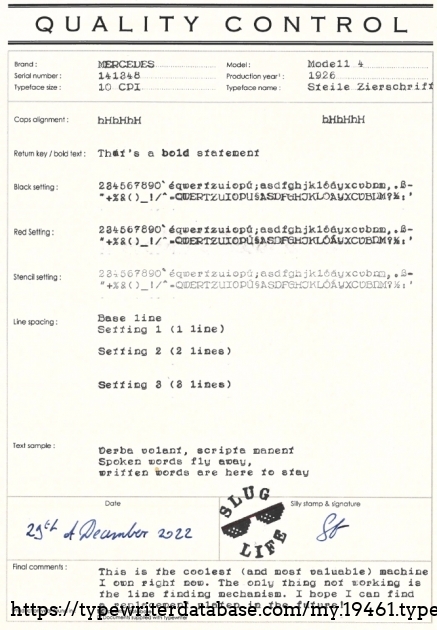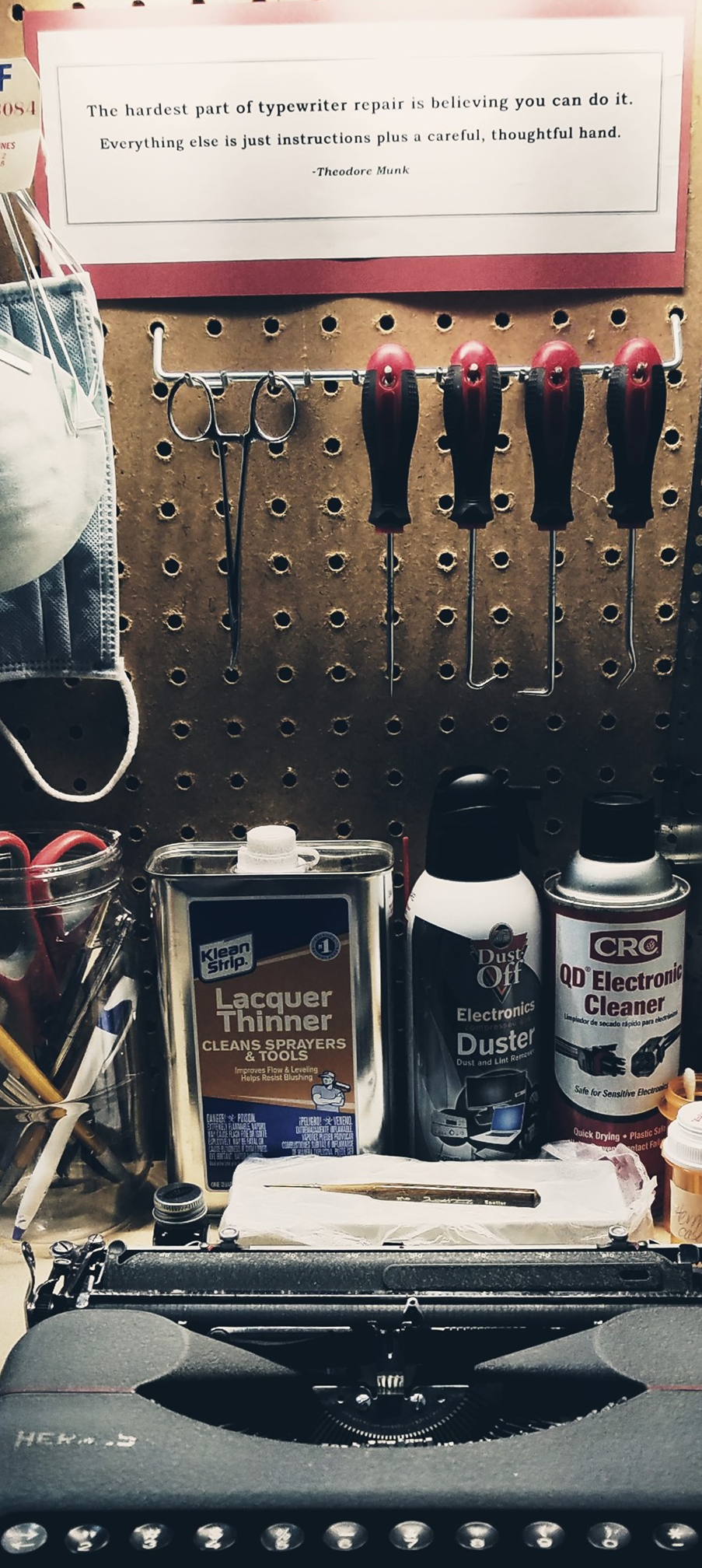Crash course on typewriter maintenance and repair
A list of resources and references for the budding typewriter repair person. There is a lot here that I've compiled and consumed over the last six months, so don't be overwhelmed. Half the battle is figuring out where to find all these things, so if nothing else, this should shave off a month of reading and researching.
Basic Introductory Material
Get a notebook and be ready to take some notes so you'll remember where you found the random information you're bound to pick up over time and are able to occasionally review it.
Work your way through Sarah Everett's excellent Typewriter 101 videos (at least the first five): https://www.youtube.com/playlist?list=PLJtHauPh529XYHI5QNj5w9PUdi89pOXsS
Read Richard Polt's book which is a great overview to the general space:<br />
Polt, Richard. The Typewriter Revolution: A Typist’s Companion for the 21st Century. 1st ed. Woodstock, VT: Countryman Press, 2015.
Next watch the documentary California Typewriter. Documentary. Gravitas Pictures, 2016. https://www.imdb.com/title/tt5966990/. It has some interesting subtle material hiding within it, but it will give you a good idea of where you're headed off to.
Get a machine (or four) you can practice on. Get a flat head screwdriver and maybe a small adjustable wrench. Buy some mineral spirits and a small headed toothbrush and clean out your first machine. Buy some light sewing machine oil and try oiling it. Search YouTube for videos about how to repair anything that may be wrong with it.
Basic restoration advice: https://site.xavier.edu/polt/typewriters/tw-restoration.html
On colloquial advice for degreasing, cleaning, and oiling manual typewriters https://boffosocko.com/2024/08/09/on-colloquial-advice-for-degreasing-cleaning-and-oiling-manual-typewriters/
Repair Manuals
Create an account on typewriterdatabase.com which will give you some additional access to catalogs, manuals, and dealer catalogs.
They also have some openly accessible material like:<br />
* https://typewriterdatabase.com/manuals.php
Printed manuals: https://www.lulu.com/search?adult_audience_rating=00&contributor=Ted+Munk&page=1&pageSize=50 PDF manuals: https://sellfy.com/twdb
Ted Munk's website also has a plethora of ephemera that is often useful
* https://munk.org/typecast/
Richard Polt's list of service manuals, which also includes some correspondence course typewriter repair classes: https://site.xavier.edu/polt/typewriters/tw-manuals.html#servicemanuals
Tools
In rough order of increasing complexity:
Tools can be expensive, so start out small with just a few things and expand as you need them. You'll be amazed at what you can accomplish with a single thin bladed flathead screwdriver, an adjustable wrench, a rag, a bottle of Simple Green cleaning solution, and a bottle of isopropyl alcohol.
Videos
Subscribe to and become acquainted with YouTube channels like the following:
While watching a variety of videos is great, as you're doing specific repairs search YouTube and you're likely to find full demos of the repairs you're doing yourself.
I've compiled a playlist of videos for repair of an Olympia SM3 which, while specific to the SM3, is a an excellent outline/overview of how to disassemble a portable typewriter, where many of the adjustment points are as well as an outline of the order to do them in.
If you're not a good typist or don't have experience in the area, try out some of the following short films which will also provide some useful historical perspective:
Internships & Apprenticeships
If you have the time and flexibility try arranging an internship or apprenticeship with a local typewriter repair shop. Meet your local repair people even if you can't spend the time on an internship. You'll learn a lot and create relationships with businesses who will more easily swap/supply you with machines they're parting out or access to tools which may otherwise be difficult to source.
Podcasts
Some useful Bibliography
- Athey, Ralph S. Typewriter Repair Training Course. Tarentum, PA: Typewriter Repair Training, 1957. https://site.xavier.edu/polt/typewriters/AtheyTypewriterRepair.pdf.
- Atkinson, Annelise. Typewriter SOS: The DIY Guide to Fixing Common Problems with Typewriters, 2014. https://www.amazon.com/Typewriter-SOS-Fixing-Problems-Typewriters/dp/1520902700/.
- Hausrath, Alfred H., and Eugene L. Dahl. Typewriter Care. Edited by Walter K.M. Slavik. Federal Work Improvement Program United States Civil Service Commission and Government Division, U.S. Treasury Department, 1945. http://archive.org/details/twcare-1945.
- Jones, Clarence LeRoy. The Manual Typewriter Repair Bible. Edited by Theodore Munk. The Typewriter Repair Bible Series, 2017. https://www.lulu.com/shop/ted-munk/the-manual-typewriter-repair-bible/paperback/product-1vgk72jp.html.
- Kasten, R. M. “First Aid for Typewriters.” Popular Science Monthly, May 1941.
- Kravitz, Bryan. Hints for a Happy Typewriter. Bryan Kravitz, 1983. https://site.xavier.edu/polt/typewriters/Hints-Happy-TW.pdf.
- Hutchison, Howard. The Typewriter Repair Manual. 1st ed. Blue Ridge Summit, Pa: Tab Books, 1981. https://www.amazon.com/typewriter-repair-manual-Howard-Hutchison/dp/0830600345.
- Munk, Theodore. “The Typewriter Database,” 2012. https://typewriterdatabase.com/.
- Pearce, H. G. Complete Instructions: How to Repair, Rebuild, and Adjust Underwood Typewriters With Handy Reference for Locating Trouble Quickly. Bridgeport, CT: Typewriter Mechanics Publishing Co., 1920. https://johnesimmons.com/Typewriter/Articles/Manualpdf/Underwood_Repair_Manual.pdf.
- Polt, Richard. “The Classic Typewriter Page : All About Typewriters,” 2009. https://site.xavier.edu/polt/typewriters/index.html.
- Scadden, David T. Approved Home Study Course in Typewriter Repair and Service. Little Falls, NJ: Typewriter Repair School, 1959. https://site.xavier.edu/polt/typewriters/homestudycourse.pdf.
Good luck on your journey!
reply to u/fontinalispluma at https://old.reddit.com/r/typewriters/comments/1gaza5x/learning_typewriter_maintenance_and_repair/





